I wanted to build the ducks a pond. In fact, I started on the pond months before we eventually adopted ducks.
Now, just so we are clear, our pond isn’t really a pond…it’s more like a very large puddle. It’s about 15 feet by 8 feet and holds about 1000 gallons of water. But for all that, our three ducks are thrilled with it and the already impressive biodiversity of my garden has skyrocketed since we added a permanent source of water for our many insect, bird and critter friends.
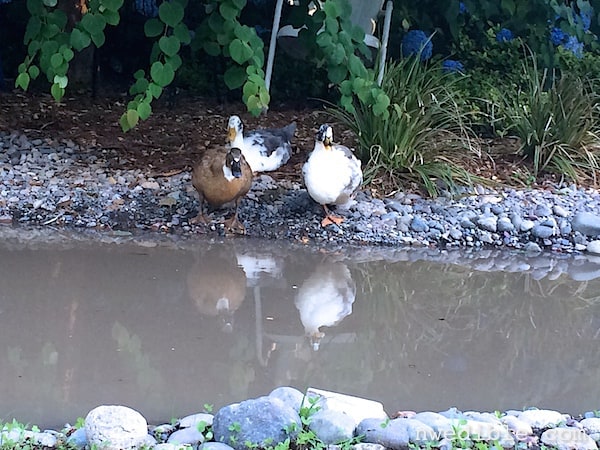
I was totally convinced when we embarked on this pond experiment that I did not want a plastic pond liner. I use plastic tunnel cloches all the time, and will even use black or red plastic mulch to increase the soil temperature around my plantings, so I’m not an anti-plastic zealot, but in this case, I knew the ducks would be walking in and around the pond (ducks have surprisingly sharp nails on their feet) and would root in the mud around the edges of the pond.
So what I didn’t want was something that would became nearly useless if punctured. I also wanted a more graduated wet to dry zone that would support more plant life along the perimeter of the pond.
After some Google Fu I discovered that many people discuss the possibility of using clay kitty litter to seal a pond. Clay kitty litter is composed almost entirely of bentonite clay, and it made sense that if I added a sufficient amount of clay to my native soil, I could create a more natural, packed-clay barrier that would hold water.
That was the theory at least.
The leading internet minds seemed to agree that the best litter was the cheap “Special Kitty” 100% clay litter sold only at … wait for it… Walmart.
Fast forward past the week-long internal debate where I go back and forth about the ethics of breaking my multi-year boycott of all things Walmart in order to get a $4 bag of cat litter for my pond test. I’m standing in the Walmart checkout line with my blue and red paper bag of Special Kitty, behind a woman with a cart full of Ortho Groundclear, Bayer Complete Insect Killer, and “Premium Songbird Food.”
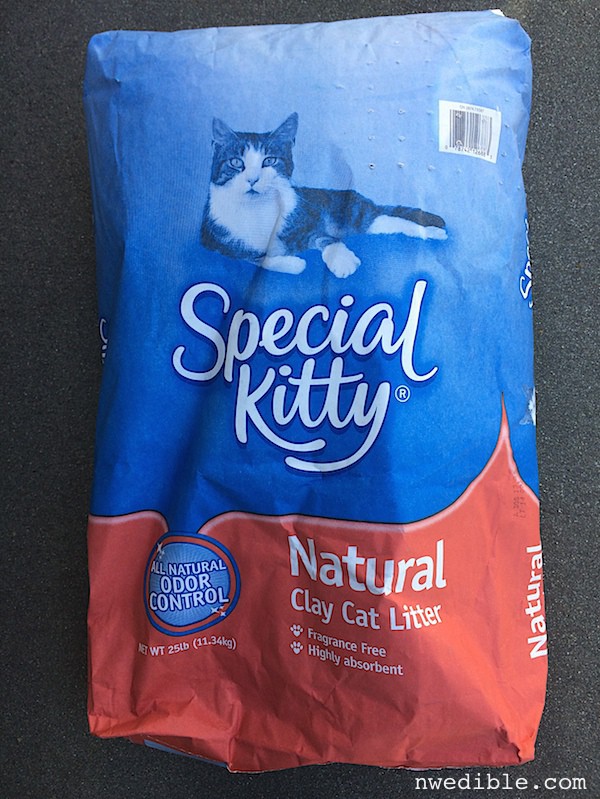
I manage to keep my mouth shut and avoid getting into a checkout line punch-out scenario over organic gardening ethics, I pay my five bucks and I head to my car. At this point, only one thing is going through my head: if this clay pond kitty litter thing works, I’m going to have to come back here and buy a ton more Special Kitty.
It was a very conflicted time.
Does Special Kitty Cat Litter Work To Seal A Pond?
Test one: pour two cups of 100% clay Special Kitty Cat Litter into a mason jar. Fill jar with water. Observe.
Observation: Basically nothing happened. The litter just sat there like small rocks at the bottom of the jar. Even after three days and attempts to pack down the wet litter, there was no indication that the litter was swelling or merging to form a clay layer.

Test two: drill several holes in the bottom of a bucket. Fill the bucket with several inches of Special Kitty, followed by several inches of native soil. Pack down. Observe.
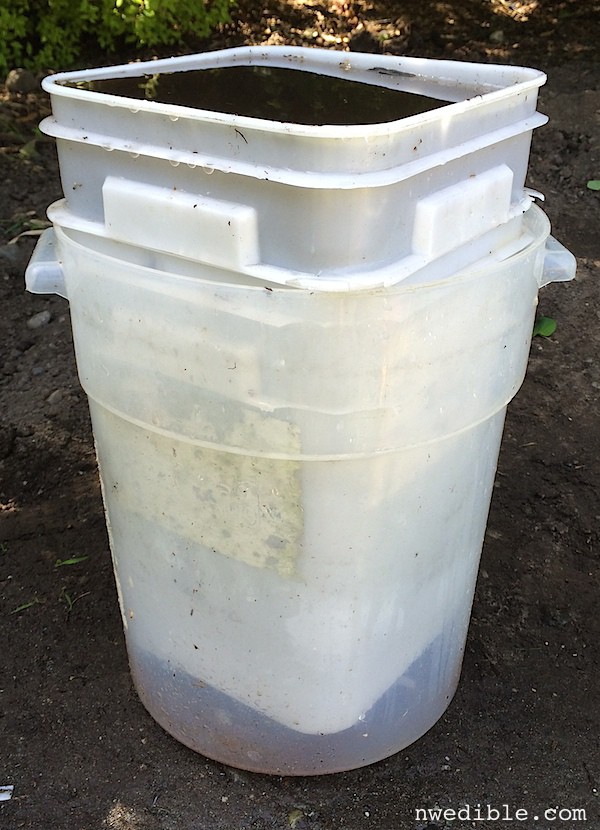
Observation: the water slowly filtered through the dirt and Special Kitty, and it all leaked out the bottom of the bucket.
The Special Kitty from Walmart was not going to work for sealing my pond. Kinda a bummer. On the other hand, I never had to go to Walmart again. All things considered, I could live happily with the outcome of this experiement.
But dammit, I still wanted my clay lined pond.
Not All Bentonite Is Created Equal
Back to the Google. Turns out there are two kinds of bentonite used in kitty litters, calcium bentonite and sodium bentonite.
Calcium bentonite is used in cheap, granular litters like Special Kitty, and has about a million other industrial and processing uses, and the hard core hippies even use the food grade version for internal and external detoxification. All well and good, but not particularly helpful for sealing a pond.
Sodium bentonite is different: it has this incredible, swells-massively-in-water properly that makes it useful in applications where you want very low permeability from one side of the bentonite to the other. Like lining landfills, or drilling oil wells.
Sodium bentonite is the main component in (as you might expect) clumping cat litter. That thing clumping cat litter does where is swells around cat pee and becomes a hard, almost rock-like clump? That’s the same feature that makes sodium bentonite useful for sealing duck ponds.
My updated goal was to get my hands on a cost effective clumping cat litter with as few additional ingredients as possible. I was ok with baking soda because I figured I could pH neutralize that if needed, but I didn’t want a litter with a bunch of weird chemicals designed to mask odors.

Unfortunately, the purest, 100% sodium bentonite litters are specialty items that failed the cost effective test, but the cheapest clumping cat litter at Costco seemed mostly harmless. It had baking soda and some lemongrass scent but was worth a shot.
Does Clumping Cat Litter Work To Seal A Pond?
Test one: pour two cups of Sodium Bentonite Clumping Kitty Litter into a mason jar. Fill jar with water. Observe.
Observation: Holy crap! The top of the litter absorbed water and turned to a layer of slimy clay goo so fast the water never even made it all the way to the bottom of the jar. Most of the bottom layer of clay remained dry for days, and I have no doubt it would have remained dry indefinitely, but eventually I wanted my jar back.
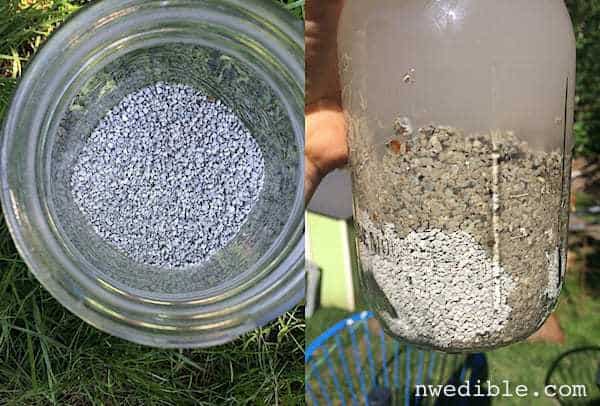
Test two: drill several holes in the bottom of a bucket. Fill the bucket with several inches of Clumping Cat Litter, followed by several inches of native soil. Mix soil and litter together and pack down. Fill bucket with water. Observe.

Observation: After an initial settling where some air bubbles burbled out of the soil and litter, the water level stabilized and remain basically unchanged for several days. The slightly loss of the water in the bucket was so small that it was likely just evaporation or measurement inconsistencies.
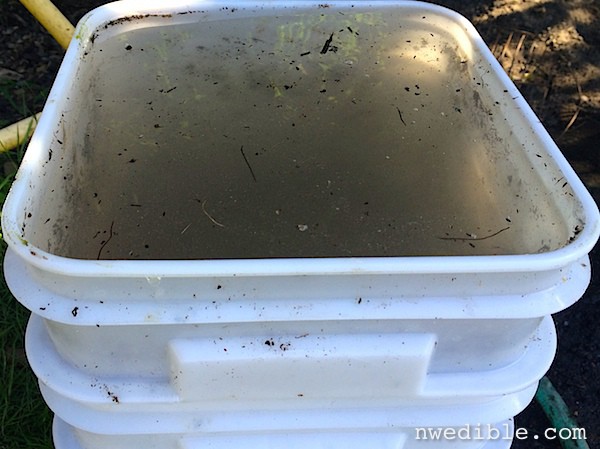
Conclusion: for pond sealing in this way, clumping kitty litter made of sodium bentonite is essential. Here’s what happen to a little bit of (clean, duh) clumping cat litter mixed with water:
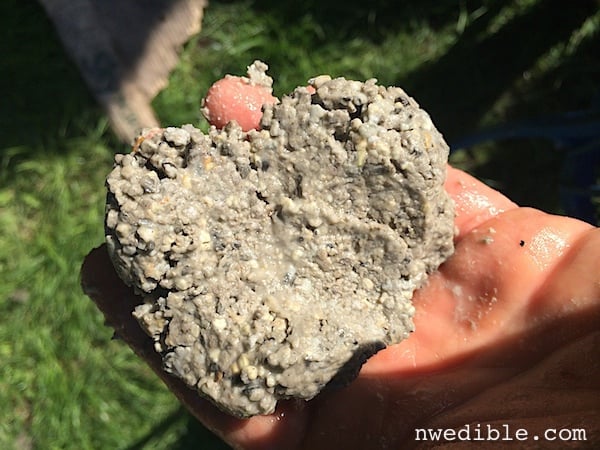
As you can see, it basically turns into super clay.
Next time, I’ll cover the details of how we actually used the clumping cat litter to seal our pond. Spoiler alert: it worked! And Walmart didn’t get another dime from us for the project!
Happy ducks in their big mud puddle:
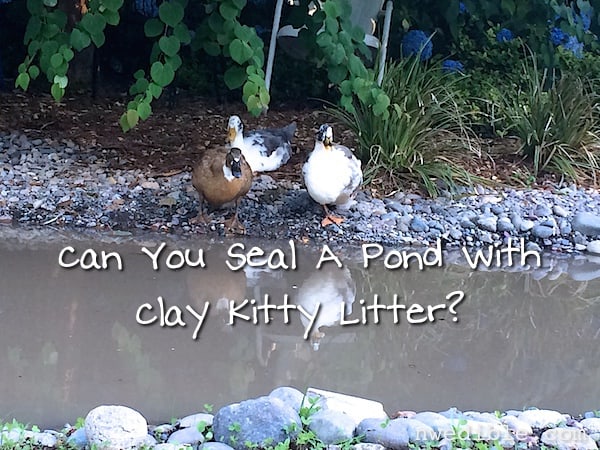
One time I dumped a box of clumping cat litter that we used on a garage floor in a rocky hill area on my old property. It did like your test but the clump re-slimmed up every time it rained. It was gross. There are liners made to contain bamboo, I don’t think a duck will hurt that.
Hah! Yes, totally. The slime factor is something we realized (I’ll talk about that in the next post about the pond). You can’t just put down kitty litter – it must be mixed with the soil. Then it forms something kinda like dirt spackle. Places where we “sprinkled on extra for good measure” we had to go back and cover with more dirt because it was way gooey.
Okay, I think at this point you exist only to feed my little duck dreams (says the person with too many chickens at the moment, sigh).
Seriously, this is SO COOL. Can’t wait to read the rest.
You know what? They are so much less destructive than chickens. I do like my chickens, but when they escape, half the vegetables get uprooted or eaten and I can follow the path of dust-bath destruction through the yard. The ducks are just much more heads-down, patrolling for slugs. I’m kinda in love.
I love that you experiment so that we don’t have to. 😀
Also: YAY for happy ducks! 😀
Will you eventually be growing water plants in your giant puddle or are you just opting for “small body of water in the yard”? Also, are you aerating (airating?) the water at all? Is it going to wind up stagnant if you don’t? Thoughts? Plans?
The thing about ducks is they will eat most plants that will grow in water. That said, yes we have big plans for some reeds to will soften the bank but do not plan on relying on plants for proper filtration of the pond. We have a big recirculating filter thing we are tinkering with now that is doing a good job of helping with filtering.
As a brand new (Muscovy) duck owner, I also hope to read more about any plans for aeration and draining/replenishing your large puddle.
It looks great!
You absolutely will. At the moment we are tinkering with a badass 55-gallon swirl filter that is doing a lot to reduce murkiness and muckiness. More on that system, including a how-to, when it’s ready for prime time.
New to your blog, love all the info, thank you! I’ve been looking but haven’t found it yet – is there a link for the filter info? I’d love to consider a duck pond but the filter would be great to install also. Thanks!
I am having a bit of a rough a morning this morning. The best thing possible for a rough morning? 42 seconds of happy, happy ducks in a homemade pond. (I have decided that when they waggle their tail feathers it is like a dog wagging its tail. It doesn’t matter whether or not this true. It makes me happy to think it.) Thank you for the video – and I am looking forward to learning more.
Glad the happy ducks could improve your rough morning slightly. They are so pleasant to be around. Hope your day gets better!
I read that animal manures with some vegetation creates a biofilm that will also seal a pond.
http://www.permies.com/t/3409/ponds/Gley-technique-sealing-ponds-dams
Yes, I was just talking to Paul Wheaton, the Permies.com guy about this!
can i ask why you didnt just get bentonite from home depot or other such store? it’s what we used for our (huge) pond. is kitty litter cheaper?
They didn’t have any. 🙂 I even went to industrial building supply places and basically my only option was ordering a pallet load from Texas. I think if people have the option of buying pure sodium bentonite locally that’s ideal.
I can’t say enough how much I love your blog. You are so good at giving us so much good information. Can I ask how big your property is, just curious, and do you have to worry about your ducks flying away? Thanks.
Carol
1/3rd acre, and this breed of ducks don’t fly. They are way easier to contain than chickens.
So glad you are figuring the duck thing out! They don’t crow, and chickens really do tear up the ground…. I’ve been pondering bantams.
I’ve been interested in bentonite for years, to increase the water holding capacity of my sandy soil. Elliot Coleman recommends it as a general soil amendment, citing a German study showing it improved growth. Years ago I got some broken bags from a drilling supply company (it is used to seal bore holes) in Fife, but it is long gone. So glad to know about the difference between the regular and clumping cat litter!
Ducks rule. Fo’real.
You’ve just cleared something up for me. Years ago I read a tip about keeping kitty litter to user for traction like sand when it’s snowy or icy. At the time where we lived the driveway sloped down from the street so getting out when it snowed was iffy. As we had cats and an abundant supply of clumping litter, next snow I tried it. Slippery, gooey, slimy clay on top of slippery, cold, icy snow in driveway. What an awful mess! Now I understand why it didn’t work. That Wal-Mart litter, on the other hand might have actually done the trick.
Also, I’ve had an identical Wal-Mart experience when I bought that litter to use as growing medium in the decisive container pond I had four a couple of years. In that case it wasn’t supposed to break down. It was supposed to work like the very expensive pond growing mediums that may actually be baked clay particles. It did work in that case.
Also, I’ve had the same Wal-Mart experience when I bought that litter for the container pond
Ugh, sorry for the weird structure and half duplicating sentence. Commenting from my phone does not work well. 🙁
fireplace ashes make traction instantly, and wash away with the next rainstorm… as long as the distance to the house is far enough to keep from tracking it in the house, it works great. Also, make sure there are no nails or metal in the ashes!
It’s funny to me that Walmart is the devil while Costco is acceptable, and the difference between them is apparently so clearcut that you don’t explain why.
Thanks! I didn’t say I disagreed, just that it was assumed to be known 🙂
Hah! Good point. 🙂
You can order bags of bentonite from your local farm store. They don’t carry it but will order it for you. We have two bags in our garage right now that we bought from “the country store” or farm co-op.
Great to know, thanks!
Best blog post title ever. I sooo want a pond in my future–can’t wait for the details. Like a prior commenter, I am curious how much land a person needs for a pond to feel natural… (the spot I have in mind is 3.5 acres, which I’m hoping could support a few projects)
Well, you have about 11 times the space I do, so I’d say you can do everything!!! 🙂 Just spit-balling, but I think a pond maybe 40×40 or larger could feel quite natural if well integrated with the landscape. The larger it is, the easier it will develop a self-regulating ecosystem, too.
I Wilkerson, 3.5 acres should support a nice size pond. You need to determine your watershed area, will it be dependent on run-off and rain to fill (also susceptible to drying out and contaminated run-off) or will you have a spring or two to fill it. There are a couple nice books, THE EARTH POND by , I think , Mattson and THE POND LOVER by Langsdon.
I watched Paul Wheaton’s “World Domination Gardening” pond video, and it’s helpful to see how they placed it and checked the clay content of the soil, and actually built it (with an excavator).
Erica, how do you deal with the issue of mosquitoes breeding in the pond? I love the idea of adding a few ducks to our avian family (we have 13 chickens now), but I’m allergic to mosquito bites and a bit paranoid about giving them a breeding ground.
The current mosquito abatement strategy is “ducks and pumps,” I suppose. The water is anything but stagnant, what with the quackers jumping in and out and swimming around. We’ve also got what should be a pretty solid filtration system evolving, and it is set up (albeit unintentionally) to create a pretty nice swirl current in the pond. So the water should stay pretty mobile and hopefully decently clean. Only time will tell if it is enough, but we’re not too bad of a mosquito area (I grew up in California, where bug guts on the windshield) could occasionally create unsafe driving conditions after just a few minutes on the road.
Thanks for the reply, that makes sense. I grew up in Alaska (where mosquitoes are the state bird), and am now about 100 miles north of Seattle, so I shouldn’t whine – our mosquito issue is pretty minimal. It sounds like the pump/filtration system is the way to go.
The other mosquito plan is fish. In fact, even before we let the ducks in the pond I bought a dozen feeder goldfish (a dime a piece) and let them loose in the pond to eat mosquito eggs.
Don’t the ducks eat the goldfish?
So timely. I inherited a leafboghorrorshow – I mean pond – with my property last year. I cleaned it out this spring and clearly damaged the liner somehow. It’s now in the process of completely drying out. (sigh) But, this might be a solution.
Hey ya never know – maybe the problem is the solution! Maybe your pond will end up being the best thing ever!
This might be a good point to break into this subject. Sorry, but my ducks (3) are plastic, but I have twenty-three asst’d fish. My pond is only 16x4x4 , but I am using the liner from my previous pond that was 24x14x4 i.e. three times too big with lots of folds. It looses about 3″ overnight, another 1-2″ the next day, then sort of stops – I think – I’ve never left it more than four or five days. The UK price of Bentonite Sulphate is a bit high, but a 10kg bag of litter is well within the budget. My only concern is whether or not the resulting Goo would pile up inside the folds and find / seal the offending gap or gaps? Any ideas or viewpoints would be muchly accepted.
Hard to say – my guess is the goo would seal up the cracks, but my bigger concern is the pH impact on your fish – be careful with this in a fish pond – I’m not a fish expert but I think the bentonite could negatively impact the water quality for the fish, at least in the short term. Good luck!
Just remove the liner and use the kitty litter… Maybe mix with some water, trowel it on, and then cover with soil or sand… or maybe spread it dry, cover with sand, and spray lightly with water (to not disturb it until it’s set) before filling the pond. If it were me, I’d dig in a plastic drainpipe and maybe add some circulation/aeration pipes before putting the litter down, even if you don’t use them to start with.
That is so freakin cool! I’m still anxious to see a map of your yard, as I am constantly amazed by everything you have going on! That little duck puddle would probably take up 1/3 of my little yard, but I desperately want one now! Those duckies are sooooo cute and happy!
Thanks for the reminder! I’ll try to climb up on the roof and take some photos for next week.
I really, REALLY, want to live in your back yard!
Thanks! But I’d make you weed. 😉
Would you please be part of a garden tour someday (ie Seattle Tilth, Edmonds, etc) so I can visit!
I consider it every year but I’m kinda spooked at letting a ton of people walk through my yard. Maybe I’ll host a reader open house next summer.
Having hosted an open garden before, it does feel a little bit like showing your underwear drawer to the world. But we got so many great complements and two years later people are still saying “wait…you mean that house by the mountain? That was great! When are you opening again???” It’s a way better experience than you think it might be. We’re going to do it again next year! (Plus, it makes for an excellent deadline for those things you want to do but never seem to get to.)
Wow! I can’t say I’m planning to dig a duck pond anytime soon, but this is a super interesting piece of information nonetheless. Always more knowledge! 😀 Also, my spouse and I may have an inside joke about Special Kitty because it seems like a completely ridiculous name for a product intended to deal with a basic non-special bodily function. “Special Kitty! You’re such a good pooper! SO SPECIAL.”
LOL! Totally. Yes, I agree: for most cats, praise isn’t really necessary to get them a-pooping. It should be like, “Special Kitty! You didn’t ruin my couch today! Great job!”
Damn you! You’ve gone and done it again…..I had almost, just almost convinced myself that I didn’t need ducks to add to the chickens and goats, but NOW? Well, now I gotta have some of those quackers….MUST. HAVE. DUCKS!
Seriously though, I appreciate the ingenuity and thoughtfulness of your experimentation. I didn’t want to dig a pond with a plastic liner and you have just solved that problem. I love the natural-ness of it….if it fails then you don’t have this big gob of plastic to dispose of (and un-recyclable plastic “trash” is something I hate almost as much as Walmart).
Mwaaa haa haa! My goal to spread the good news of ducks is working! 😉
Hi Erica! I would love to get a few ducks. My chickens are a little noisy and I’m afraid if ducks are too, it might send my neighbors over the edge. Can you tell me if yours are noisy or quiet?
The quackers are vastly, vastly quieter than the cluckers! At least for our anconas this is true. But the ducks don’t seem to feel the need to announce every egg laid or get into noisy territorial re-matches every night about who gets to roost next to who…
Hubby says your website should be banned. Something about my jabbering about the corner of the yard +shovel+ Erika did it!+DUCKS, honey, DUCKS!…No idea what he’s talking about. I think I may have to start digging tomorrow.
LOVE the video of the ducks. Such happy quackers!
This is how it starts….. 😉
I have been trying to redo my leaking pond, and learn how to use bentonite clay, for years! This is so very promising and exciting!
This is a very intriguing use of kitty litter 🙂 I know some are opposed to liners but if you aren’t able to do the clay, a good heavy duty and fairly inexpensive option is recycled billboard tarps. We use one in our duck pond and the heavier ones are very resistant to the duckies. We have our pond set up with an overflow drainage ditch that goes along our tree strip. Flushing the duck pond and watering the trees at the same time.
I ordered 18 ducklings with my layer flock this spring & I have to say I love the ducks way more then the chickens. I have Pekin, Khaki Campbell, Cayuga’s, & the hatchery sent 2 others because they couldn’t fulfill the number of Cayuga’s that I ordered. We think they are Buff Orpington Ducks. I love their quacks & watching them bath in their kiddy pool. We are in the process of building a larger run for them & I’ve wanted to build a pond but the expense made me hold off. This post was so timely & I can’t wait for the follow up post. I was wondering about how to keep it cleaned because they do muck up the water quickly.
I love you blog so much & have learned a lot.
Good story. I wonder if you added a little sand with the mix if that wouldn’t seal it better? Then, on top the soil for plant growth. I’m thinking that maybe the litter would bond with the sand and a little dirt. Sort of like filling all the different size cavities
Funny thing, Special Kitty isn’t even useful as kitty litter. It’s basically the most useless litter ever.
Why not use straight bentonite clay? I have acquired it from farm and nursery supply outlets and used it on ponds and even the roof of a parking garage that was leaking. Another source may be a pottery supply outlet.
Very cool!
Are there any potential problems with the sodium leaching into the soil or water?
Carol Deppe already made me want to have ducks. Alas, wrong side of the Cascades. And I never even got chickens reinstalled. But, fun read and I love your scientific approach.
Love your pond! I’ve been considering doing something like this for our ducks. But the poop, stink problem has dissuaded me. Can you say more about your filter system? That seems key.
I’d like to expand on this subject mainly these points:
Beware, Clumping cat litter can be deadly depending on if your cat ingests it.
Non clumping cat litter can be a very good repurpose natural soil amendment!
Not buying from Walmart will not fix the problem of inequality of income.
Consider joining groups who are working on educating on the subject of permanent solutions such as http://www.livingincome.me
Thank-you
Yes it seems the clumping litter and dust can be deadly dangerous if inhaled or ingested by your cat and especially your kitten.
The old fashioned non clumping litter may be the way to go for many.
REPURPOSE:
Non-clumping litter (natural CALCIUM Bentonite clay):
*I’D LIKE TO POINT OUT THAT THE NON CLUMPING LITTER CAN BE A VERY GOOD SOIL AMENDMENT IMPROVER FOR YARDS AND GARDENS AND POTTED PLANTS WHEN TILLED OR THROWN ON TOP-PREFERABLY WITH A FERTILIZER BROADCAST SPREADER!*
From what I’ve read, the non clumping litter is hard and does not break down or become mushy when wet or over time, it helps break up your soil, hold moisture and nutrients for use by plants and adds air to the soil. People buy the stuff new just for this purpose, I wouldn’t hesitate to use it for the cats and then dispose of the used by this method where it will serve your yard plants for decades to come.
The rain and watering should wash out the harmless cat urine.
We’ve been throwing away this wonderful natural soil amender we paid for and hauled home, all these decades!
Clumping litter (natural SODIUM Bentonite clay):
I see on another site “can you seal your pond with clumping cat litter” the clumping litter was used by a person to line a backyard duck pond to stop water loss. Clay to stop water loss in ponds is the old school method, instead of modern rubber sheet like liner material.
If your building a pond, you might consider this natural liner method…
I went through a huge learning curve trying to figure clays. Not for ponds but just to increase water holding and ion exchange capacity of 100% pure sand that is my yard. I came up with the same conclusion regarding sodium bentonite but ended up purchasing large bags from our local well driller. They use this to seal up old well heads. It was cost effective and I didn’t go near a Walmart. Also I discovered there is a whole market for beneficial agricultural clays in Australia. They are marketed just for the high sand “soils” they have. I had great success using the sodium bentonite, in combination with other soil and composts, to create a very wet area garden and even grow butterbur!
Thank you so much for this well documented experiment!!!!!
I just stumbled upon your site while looking for advice on a non-plastic liner solution for the wildlife puddle I want to install in the backyard (I have no duck plans, but I’m hoping for frogs, dragonflies, and ultimately spotted salamanders). I think this post was very helpful!
First off, I must say, this is genius!
Second, I love your writing style, you are hilarious.
Thirdly, how do you keep the pond clean? Do you have maybe a blog post about that?
Thanks so much, my gang of 12 ducks and counting is looking forward to this!
Thank you for the advice about cat litter. I am not building a pond, but rather a small dam across a small stream that often dries up in the summer and winter. It is apparently at the water table level and reacts to the ups and downs of the table. I wanted this dam to be basically waterproof so it would retain any water in low periods. Mixing in the sodium bentonite clay did the job for me by sealing up the spaces between the rocks in the dam. I had trouble finding Pet Pride brand litter, however. But then I discovered that the standard Wegman’s brand is 100% bentonite clay. The label doesn”t say whether it is sodium or calcium, but I bought some and tested it and it works great. I am attempting to retain the water in my stream by digging down into the ground below the water table now. Hopefully this will allow me to keep fish in the stream.
Hey, do you know if granular bentonite is okay to use? Here’s the description, “Granular Bentonite is natural, granulized, high swelling Wyoming sodium bentonite. It is recommended for lining/ sealing applications involving moist soils or those where it is necessary to minimize dust generation.” I’m in a similar situaiton, I can’t find anything local but this sells at 11.00 per 50lb bag. So, seems cheaper than other products I’ve seen in my search. Idk, anyone have any thoughts?
Whats wrong with walmart . You stupid liberal hippy. Go take a bath and get a job. Probably have a hillary bumper sticker on your subaru too 😛
Hi, I loved this article…..and can’t stand Walmart. I will be getting a bunch of the correct kitty litter and doing my pond. Thank you for the great info.
Tim D
I just found this article… I wasn’t sure what the clay was called, and HD/Lowes were not much help…
I have 70′ diameter pond and the spill-way pipe is leaking at a joint. I’m taking advantage of the drought to fix this 4-year old leak – basically, the pond level has been 4 feet lower than planned for all that time (the other half of the pond is about 20 feet deeper). The water level is now 4 feet below the spill break, and there’s bare ground leading up to the pipe. I’m going to glue and tar the joint, pack the clay around it, and then dump a load of rock and dirt around it to stabilize the thing. My ducks love the pond, but I’d love it more if it was full!